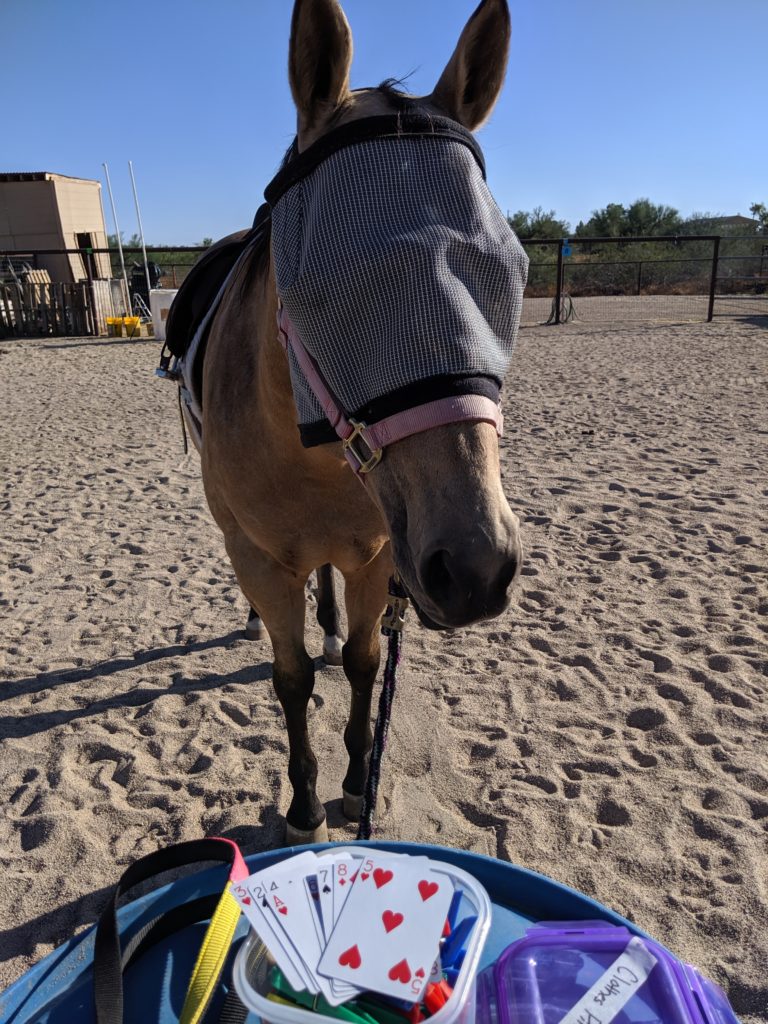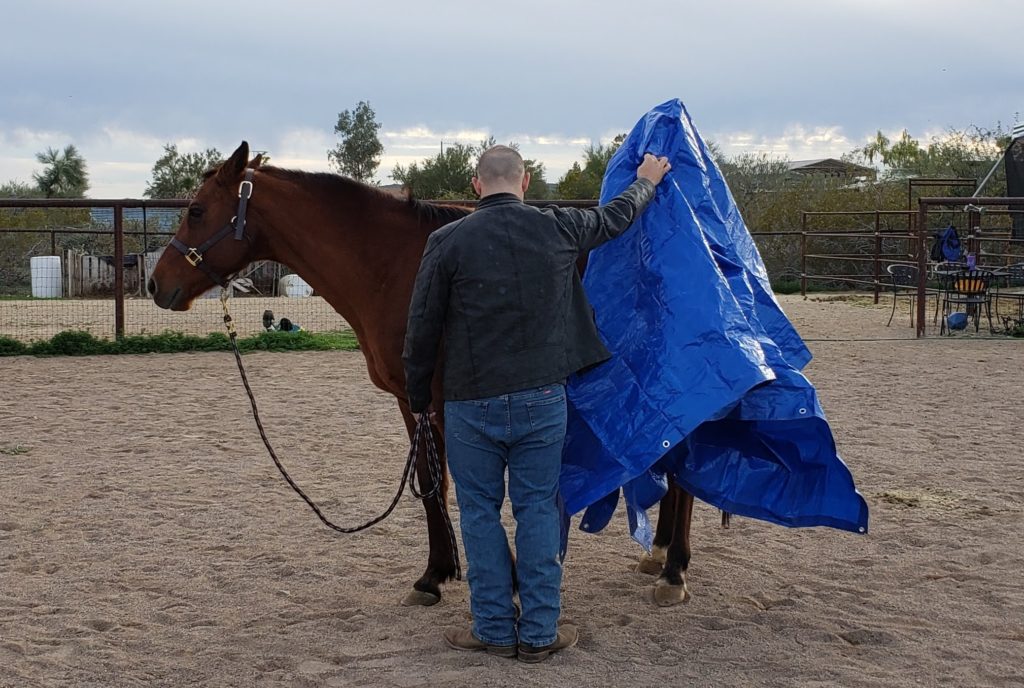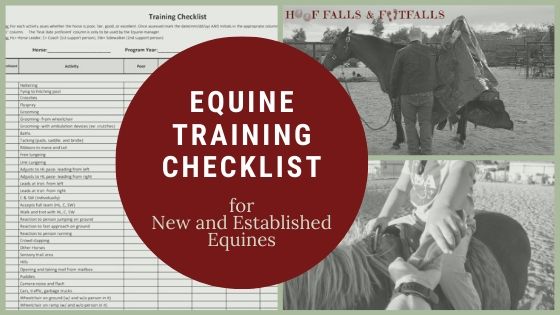Why should an instructor or center have (and use!) a document like the Horse Training Checklist?
It is best practice that instructors and/or centers offering Equine Assisted Activities and Therapies (EAATs) keep regular documentation of evaluation and training of their equine co-workers. “Regular” documentation means that it is an ongoing practice and not done once or twice during the horse’s time working in EAATs.
Using a consistent document template for evaluations and check-ins also aids in keeping things consistent, helps ensure important training/evaluation areas were not missed, and hopefully make it easier for more than one person to help maintain the documentation
Having consistent, thorough documentation on file can also help back up an instructor or program in the case of an accident. If it has been documented on several occasions that a horse has been exposed to an item (say…a basketball) and has been consistently with it, then in the case of an accident where a basketball may have been involved the instructor or center can back up that they incorporated the basketball in a well thought out and safe way and were not negligent. This type of document gives written proof that they exposed the horse to the basketball, the horse demonstrated on more than one occasion and situation that it was ok with the basketball, and then the basketball was incorporated into lessons after safety measures and standard procedure had been followed.
Click the buttons below to download the sample documents!
Tip #1: Open up the Horse Training Checklist and either look at it first and/or keep it open as you read the rest of this blog.
Tip #2: The PDF version shows what the formatting should look like if printed. The Excel version is editable/customizable but may need formatting adjusted depending on your computer.
This sample Horse Training Checklist can help instructors and centers:
- Evaluate horses that are on trial.
- Do check in “evaluations” of current horses working in EAATs.
- Assessments horses coming back from break.
- Adjust training and schooling programs for each horse.
Bonus! If you are a Certified Professional through PATH Intl. and/or a PATH Intl. Member or Premier accredited center, this document can help you fulfill the following PATH Intl. Standards for Certification and Accreditation. If you are certified by another organization, look through their standards and guidelines to see if this document can help meet any documentation needs.

“EQM2 Does the center have written procedures for the:
- Evaluation of the suitability of new equines prior to participating in center activities/ therapies?
- Evaluation for the permanent removal of equines no longer/not suited for participating in center activities/therapies?”
“EQM3 Is there an implemented equine training and conditioning program that is specific to each equine assisted activity or therapy at the center?”
Source: PATH Intl. Standards for Certification & Accreditation, 2018
Let's take a closer look at different way you can use this document:
Evaluate horses while “on trial”:
This training checklist can serve as a guide for evaluating new horses that are on trial before being accepting in to a center through lease, donation, or purchase and working in EAATs.
Tip: Begin checklist for the horse and store in main file as documentation. Even if the horse is accepted into the EAAT program you should keep the Horse Training Checklist on file.
Use this document to track what things the horse has been exposed too and their reaction. It is best practice to have the horse demonstrate “good” to “excellent” behavior on an item on more than one day and with more than one handler before signing off that a horse has passed that section (ex: 5 separate days with 3 different handlers) . If there is a low score certain sections, this helps you target areas to work on more frequently with the horse.

Frequently asked question: What if the horse never gets to “good” in one or more items?
Answer: Depending on what item the horse struggles with you may be able to make instructors, horse leaders, and students aware of what item the horse may not be strong in and accommodate the horse’s unique personality if they are strong in key areas required of a horse working in EAATs. For example, if a horse is “good” to “excellent” in all areas except a rider playing basketball while riding then it could be made well known that the horse is not suitable for that certain game at that time. However, if a horse scores below “good” in a key area like ability to tolerate mounts in the ramp area then that horse many not be a good fit as an adaptive (therapeutic) riding horse and may be better suited for groundwork.
Do check in evaluations of current horses working in EAATs:

Once a horse has been “accepted” into your center or lesson program, the training, schooling, and documentation does not stop there!
Establish a routine to check-in with each horse. For example: Evaluate horses once a quarter on their weakest areas and every six months on other areas. If possible, have more than one person involved in the check-ins. If the same individual does the evaluations time after time, sometimes they become so accustomed to the horses they become “blind” to strengths or weaknesses.
Tip: Keep record of these ongoing evaluations in the horse’s file!
Assessments of horses coming back from break:
It is best practice to do complete evaluations of horses coming back from lengthy breaks. These breaks may be due to such things as an injury or a seasonal break (ex: the horse is out to pasture for the summer or winter.
Don’t expect the “same horse” to come back from a break! Sometimes with time off, the horses come back to work and are more or less sensitive to certain things, may or may not tolerate supporting volunteers in the same way, etc.
We also have to remember that just because a horse was used to having a student shoot hoop from their back for a session of classes does not mean that they will automatically be ok with this same activity after a break.
Keep record of these post-break evaluations in the horse’s file!

Adjust training and schooling programs for each horse
This document can be used to help create and/or adjust training and schooling programs for horses both on trial and accepted into your center or lesson program. Schooling and training cannot be “one size fits all” and should be customized to each horse based on their needs.
Once a horse has been assessed using this document, look for the Poor-Fair items and focus on them in upcoming schooling sessions to see if you can help the horse improve in those areas so they are hopefully marked Good-Excellent on several occasions with several handlers.
Remember to still check in on and school horses in all areas even if they are rated Good-Excellent! Horses, like humans, change over time and their strengths and weaknesses can change and adapt.
Tips when using this document:
- Customize to fit your needs- This document is a sample. Feel free to adjust things as needed to fit your center or lesson program! Is there a certain toy or prop you constantly use that is not on the list? Then add it on! Do you only do groundwork lessons? Then take out the mounted checklist items!
- Poor or Fair Items– Areas that are scored Poor or Fair should be documented and be made known to staff and volunteers. It is recommended that items or skills rated at this level should also be avoided during lessons with students.
- Print off a hard copy- Print off a hard copy of this document so it can easily be written on out in the barn area during assessment days. If possible, take that documentation and transfer the information into a master digital copy for the horse. This way you only have one Training Checklist for that horse to keep track of! Training Checklists can be reset each year or be a running document for several years.
- Go digital. Work smarter, not harder– Have a tablet or even a smart phone? If you have a tablet or similar item where the electronic version can be updated in the barn, then do so in real time! You can save this document on a platform like Google Drive and be able to access and update it in real time.
- Involve instructors in-training! – Evaluating, training, and schooling is also an essential and ongoing piece of equine management for those working in the EAAT industry and a wonderful skill to teach instructors early on. Give your instructors in training skills that will not only make them a stronger instructor but also set them up for success long term in more areas than just teaching. Involving instructors in training (and really any instructor) in this process also helps them to have a better understanding of the steps that need to be taken with an item or skill is incorporated or tried in a class with students.

Saebra Pipoly is a PATH Intl. Advanced Therapeutic Riding Instructor, ESMHL, Mentor, and Associate Faculty/Evaluator for the Registered level. She specializes in offering professional, affordable instructor mentoring and development.
For more information check out the Services she offers using the main website menu or email saebra.p@hooffallsandfootfalls.com

